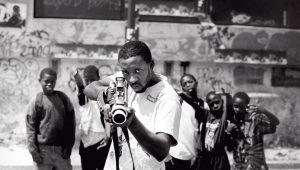A French-Malian man in his mid-twenties stands in front of a crumbling concrete building adorned in graffiti, with several young children throwing hand gestures as well as staring curiously at the camera taking the photograph.
It’s a black-and-white photograph from 2004, shot in one of the banlieues — suburban French housing projects — called Les Bosquets. The man points what appears to be a gun at the camera, his eyes looking directly at us. This is the first read.
Looking more closely, we realize that the man — his name is Ladj Ly, a French film director and screenwriter — points a video camera and not a gun. The eyes of the children and the man change as we realize that the expressions on those depicted in the image can be read differently. Everyone in the photograph seems to be aware of what is going on except us, the viewers, who have to take a second look. This is the second read.
Upon realizing that what appears to be a gun is, in fact, a camera, we become aware how we, as viewers, easily let images fall into our assumptions of what they provide. Due perhaps to the media or to clichés of visual culture, we might initially assume that the object in the hands of a black man is a gun. Not only are we guilty of making this assumption, but both Ly and the photographer seem to be calling us out by pointing the “gun” back at us. The image itself is, in fact, a weapon. This is the third read.
Photo credits: 28 Millimeters, Portrait of a Generation, Hold-up, Ladj Ly by JR, Les Bosquets, Montfermeil, 2004
